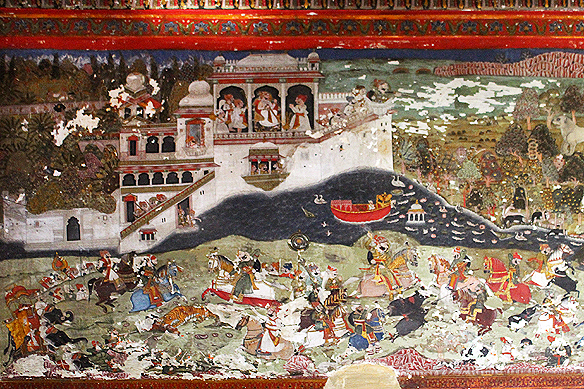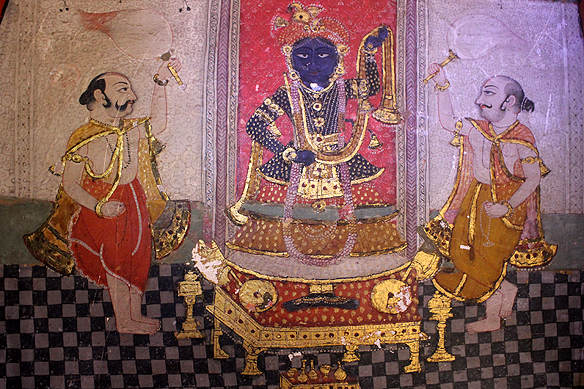A woman looks brazenly across the room. Her perfect profile decorated with jewels is tilted in anticipation. On the wall opposite, a royal damsel is being dressed by her lady-in-waiting whilst a Rajput prince slyly peeps from behind the curtains in blatant lust. Two women on a side wall make erotic love to each other.
The gods and goddesses are no less immune to the dynamics of the room. A series of frescoes have Krishna dancing in gay abandon with Radha and her sakhis in the raas leela. In another, he is perched atop a tree with the stolen garments of the gopikas.
Painted using a palette of turquoise green, black, and white, the colonnaded open-sided hall with private rooms leading out of it, was once the maharaja’s pleasure room. It is befittingly called Chitrashala—chitra meaning picture, shala meaning house or abode. The abode of pictures.
What makes these paintings, and those in Bundi’s other royal palaces unparalleled, is they comprise some of the finest examples of the Bundi School of Miniature Painting. A style normally associated with paint on paper, the Bundi school found its way in its parent city to the walls of the ruling family’s private rooms to create visual extravaganzas of colour and storytelling tipped with gold.
A key part of the Rajasthan style of Indian miniature painting, the Bundi school lasted from the 17th to the 19th Century, reaching its peak in the first half of the 18th Century. It is characterised by strong Mughal and Deccan influences. The former shows up in the treatment of the faces and naturalisation of the trees. The affinity with the Deccan style [with which Bundi had close ties] is reflected through the rich vibrant colouring.
Wrapped around the inner walls of the Garh Palace, a private property looming over the powder-blue town of Bundi, most of these paintings have never been seen by the populace. Some, such as those in the Chitrashala, and maintained by the Archaeological Survey of India, are now open to the public. And some more, should the caretaker be around, can be marvelled at such as the magical Chhatra, Phool, and Badal Mahals, piled atop each other.

Evenings of dance, music, and wine at the Chitrashala. The Bundi School of Miniature Painting on the walls of the Garh Palace bring alive the cultural and political majesty, replete with human frailties, of the Rajput Hada Chauhans in medieval Bundi.
Bundi’s pride, the Garh Palace was built over a period of 300 years—the foundation stones laid by Rao Raja Ratan Singh who ruled from 1607–31, and later added on to by his successors. Some dates to further put things in context. Both Phool and Badal Mahal date back to 1607. Chhatra Mahal, a later addition, was the handiwork of Rao Raja Chhatra Shabji (1644). Chitrashala also known as Ummed Mahal was built by Rao Ummed Singh (1749–1804) who became a saint at 42, and is still worshiped by the people of Bundi. The paintings inside were done during his and his successor’s reign [Rao Bishen Singh, 1804–21].
A Rajput stronghold, the Hada Chauhans took over Bundi from its indigenous Meena rulers in 1342. Forming strategic alliances with first the Mughals, and later the British, it stayed an independent princely state nestled in the Aravalli hills till 1947.
The last “Maharaja,” Ranjit Singh, crowned in 1977 had no offspring. When he passed away in 2010, the property fell into dispute over who exactly was its rightful owner. His nephew, Jitendra Singh of Alwar, in the meantime was made the custodian. Which has its pros and cons. The place is slowly crumbling away, filled with bats and pigeon droppings, but the art is still in its original “unrestored” splendour.
Wondering where the name Bundi came from? It was the name of the Meena founder of the town—Bunda Meena. The Meenas called it Bunda ka Nal which translates to Bunda’s narrow-ways.
Suspended in time, cut off from most modernism, Bundi has countless treasures in its lap. The most precious of all, however, is without a doubt its frescoes on its stately walls. Stories abound in these works. Of love, war, gods and goddesses, regalia and myth all rolled into one. And in many ways, illustrate a life which only the royal family and their entourage were privy to.
Shhhh. I hear the faint notes of a sitar play as a courtesan dances, accompanied by swans flapping their wings at her feet. I need to go. And whilst I am gone, do have a look at the images in the rest of my post of the frescoes I found inside the painted palaces of Bundi. 🙂

Both secular and sacred adorn the walls of the Garh Palace’s mahals. Yet each room is unique in its colour palette. Take for instance the Chhatra Mahal which is typified with its frenzy of rich reds, blues, and greens, highlighted with gold.


Krishna was a favourite subject in the Bundi School of Miniature Painting. The above fresco shows royal figures paying homage to the deity in the 17th Century Chhatra Mahal named after its builder Rao Raja Chhatra Shabji.

The Phool Mahal in contrast is more prosaic with its muted colouring, bevies of armies, and royal figures indulging in chequered board games.



Aptly named Badal Mahal meaning “cloud palace,” the once-upon-a-time Queen’s private quarters are perched on the highest floor of the palace, amidst the clouds. Badal Mahal is also the most exquisite with its deep-red petalled oriental ceiling rising from the walls, both filled to the seams with stories of Krishna, angels in alcoves, and dancing peacocks. These delicious concoctions were painted in 1607.


Vastraharan leela [part of a trilogy on Krishna stories] in which Krishna is seated atop a tree with the stolen garments of young gopikas …

Two women trapped in an embrace fondle each other’s breasts …

A lustful Rajput ogles a nude woman as she goes through her bathing rituals assisted by her lady-in-waiting, a nymph-like courtesan dances in the company of swans, and a Rajput woman offers alms to Shiva astride his mount, Nandi, with his consort Parvati by his side …
The stories covering every inch of the Chitrashala in a distinctive sea of blue and green with white figures are endless. Two hundred years ago the colonnaded hall would have been a scene of music, wine, and love-making. Today, it is a treasure trove of India’s finest miniature art. ❤

Travel tips:
- Timings: Summer: 8:00 am – 7:00 pm; Winter: 8:00 am – 6:00 pm.
- Ticket: Rs. 80 for Indians; Rs. 500 for foreigners; Photography charges: Rs. 50.
- Guide: Kukkiji at Kukki’s World. His passion and knowledge of Bundi’s history and heritage is unmatched. Cell no. +91 98 2840 4527.
- Staying there: I stayed at Hotel Bundi Haveli, a 300-year-old haveli converted into a hotel, through makemytrip.com. The rooms are gorgeous, the food in the in-house restaurant delicious, and the staff get my 5 stars for professionalism and warmth.
- Getting to Bundi: I took the train from Delhi to Kotah, and a local bus from Kotah to Bundi.
- Getting around: Auto rickshaws are plentiful. The city itself, however, is tiny enough to explore on foot. For the excursions, I was ferried around on Kukkiji’s motorbike.

Nice one
LikeLiked by 1 person
Thank you, Nancy. 🙂
LikeLike
Nice work
LikeLiked by 1 person
Hey, thank you for stopping by and commenting, Chris. 🙂
LikeLike
Wow. I am such a fan of art in india. This is amazing
LikeLiked by 1 person
Am super glad you enjoyed the post. Frescoes literally bring art to the world, and Bundi does it beautifully. 🙂
LikeLike
Awesome ….so fascinating..!!😊
LikeLiked by 1 person
Thank you, Tejaswini. I loved the stories in the paintings. They humanized history with so much charm. 🙂 Am happy you enjoyed reading about them.
LikeLike
I felt sad stepping inside the fort or palace. The signs of negligence and decay may soon take away our previous heritage. Bundi palace is one of its kind in the entire Rajasthan. Your post is inspiring.
LikeLiked by 2 people
Yup, I know the feeling. In fact I had so many locals come up to me and plead I spread the world about Bundi’s heritage coz it is all just crumbling away. How long it will last is anyone’s guess. A couple of decades at the most unless some serious measures are taken for their conservation. Or it will just flake away or be buried under droppings. Made my heart cry to think the next generation may not see these poignant treasures of another era.
LikeLiked by 1 person
I know. For a heritage lover it’s a painful to see this happening. But what can you do when the family is fighting in court case? Ask government to take a Custody?
LikeLike
But even if government should take custody there is no guarantee that it will get the rightful attention to conservation. One has only to visit Kotah palace to see this firsthand.
😦
LikeLiked by 1 person
I know Rama what you mean. But I guess that’s the only hope we have. There are some excellent conservation efforts by ASI like Khajuraho..Bhangarh. And then Amer fort and Nahargrah fort both are under state archaeological dept. I guess something will be better than nothing.
LikeLiked by 1 person
Nice work
LikeLiked by 1 person
Thank you for stopping by, Alix. Appreciated. 🙂
LikeLike
Amazed at how charmingly sensuous and graceful you can make history sound. Loved the blog. Definitely kept me glued on to read every word. 🙂
I have always loved visiting places of historic value, thanks to you, I’ve added one more to the list.
LikeLiked by 2 people
Thank you, Prachi for your lovely words. 🙂 And yes, I do hope you get to visit Bundi. It is a photographer’s delight. Both you and your camera will love this little painted town nestled in the Aravalli hills!
LikeLike
Fabulous! What lovely art and to this it has survived some 300 years! I wonder why we don’t indulge in public art anymore.
LikeLiked by 1 person
The paintings inside Bundi palace were not really meant for the public. They decorated the private rooms of the royal family, and were solely for their eyes only. Luckily for us, with India becoming a democracy, and the eventual absorption of the princely states into its fold, plebs like you and me, finally have the opportunity to feast our eyes on these masterpieces. 🙂
LikeLike
👍👍
LikeLiked by 1 person
Thanks much. 🙂
LikeLike
Had u read my poem?
LikeLike
你好,是印度吗
LikeLiked by 1 person
是。 🙂
LikeLike
哦你会汉语喲!你是台湾人吗
LikeLike
不,我是印度人。只需使用Google翻译。 🙂
LikeLike
很厉害啊!一点看不出来是软件翻译的,你的母语是英语还是印地语?
LikeLiked by 1 person
印地语。但我长大了英语。我在伦敦学习高中和我的主人。 🙂
LikeLike
哦,那你现在还在伦敦吗?
你多大了啊
LikeLiked by 1 person
现在在孟买:)
LikeLike
哦,孟买是印度最大的城市了吧!你目前做什么工作?
LikeLike
Pingback: 5 best kept secrets of bundi, india’s best kept secret | rama arya's blog
Pingback: the complete travel guide to enigmatic jhalawar | rama toshi arya's blog
Pingback: the complete travel guide to the hidden gems of jhalawar | rama toshi arya's blog